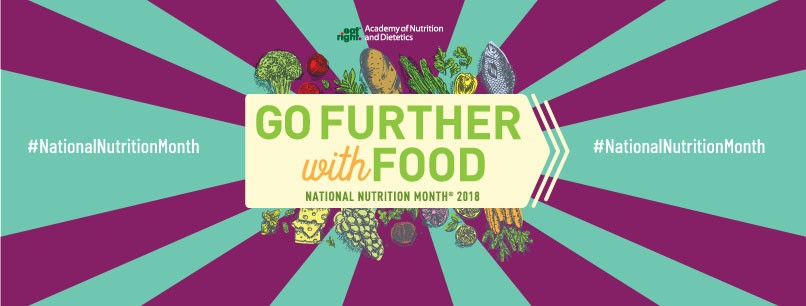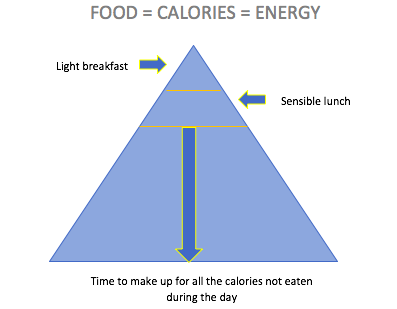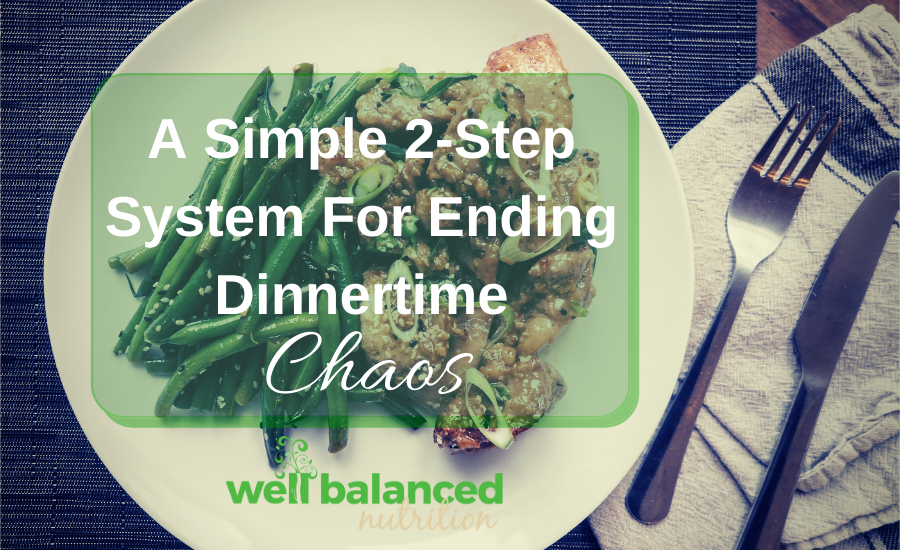
by Lucy | Mar 4, 2018 | Well Balanced Wisdom
Every March the Academy of Nutrition and Dietetics celebrates National Nutrition Month. The focus of NNM 2018 is Go Further with Food, which emphasizes the importance of making wise choices for your individual needs and reducing food waste by planning ahead.
Going further with food means meal planning, not meal plans.
Lucy and I often get requests for meal plans, and while we love to help you get Well-Balanced meals on the table, we feel strongly about helping you unleash your own meal planning powers. The key differences between meal planning and following a meal plan are flexibility, personal preference, and intuitive focus.
Flexibility
Meal plans can feel rigid. If you go off the plan you might feel like you are failing. Meal plans can’t possibly predict when you will have a long day at work or when a friend asks you to join her for dinner on a whim. They also don’t know what your budget is, what’s on sale or in season, or what’s currently in your kitchen.
Personal Preferences
Many things influence your food choices – from your culture and upbringing to your current mood. No generated or done-for-you meal plan is going to pinpoint exactly what sounds good this week or nail a plan that has you wanting to follow it to a T.
Intuitive Focus
Meal plans are often built around a calorie level or macronutrient goal but don’t allow room for intuitive choices. For instance, a meal plan doesn’t change on days when you need more fuel after an extra tough workout or your appetite is just not up-to-par for some reason or another. Only your body can tell you those things and if you are too concerned about following a plan – you could miss out on those important cues.
Don’t get me wrong, a meal plan created by someone else can be useful. It can give you inspiration or new meal ideas, a glimpse into what a Well-Balanced week could look like or get you started off on the right path. Ultimately, our goal for you is to be able to confidently make your own well-balanced plans and decisions that suit you. Plus allow for flexibility and intuitive eating.
In honor of National Nutrition Month, we will be sharing a series of posts centered around how to go further with food. We’ll cover ideas and strategies for having a plan, a backup plan, and knowing what to do if all else fails.
Food for thought: Do you plan ahead?
If you are highly organized and prepared in the kitchen this series is not for you. On the other hand, if you’ve struggled to stick to a meal plan or if you’re ready to start taking baby steps toward planning, you’ll find an idea below and more in the weeks to come.
Take the first step
If you typically don’t think ahead about what you will eat, you can start with this simple task. Take out a piece of paper while you are having your morning coffee and jot down what you will be having for dinner. Writing it down will solidify it and doing this in the morning while you are fresh will ensure you have plenty of mental stamina to make a wise decision. Once you get the hang of it, perhaps you can decide on more than one meal at a time, but for now, just focus on dinner for the upcoming evening.
Happy planning!


by Lucy | Jun 20, 2017 | Transformation Tuesday
#TransformationTuesday
Like many moms out there I have struggled with my weight and healthy eating habits. I tend to put myself last as I have 4 awesome kids that take precedence of my attention, time, energy, and money for that matter. At the end of every day I would say to myself as soon as I get the kids to bed I will workout, and well it would occasionally happen, but it never lasted. Sometimes weight would come off, but I was tired of feeling sluggish, I wanted a real health change not only for myself but for my kids.
How I started my well-balanced journey
I wanted to figure out what I could do differently and that is why I started working with Well-Balanced Nutrition, and let me tell you, my life has changed so much in less than a year. I did not want a quick fix, a fad diet, or to shame my body because I have children that are learning from everything they see me do. I wanted to provide my children with lifelong tools that will help not only me but the kids be healthy and well-balanced.
Timing is everything
I knew that I did not want to focus entirely on the scale, but more so about how I felt, how my clothes fit, and the fuel I was putting into my body. I began to meet with Lucy, who I was introduced to through my employer, and she was sent to me at the perfect time in my life. Lucy helped me have a better relationship with food and quickly I started to eat more of the rainbow, as she referred to it. This was my first tool. Make my plate colorful, the more color the better, and I am not talking about food coloring, folks. Natural colors and boy what an adventure it has been to explore so many different fruits and veggies as well as different grains. I can tell you, my 4-year-old son, he’s the youngest, loves salad, any kind, and will eat any green leafy lettuce you put in front of him with a meal and often 3 servings. It is truly his favorite food.
Tips for busy moms
As moms know we are busy, but that does not mean we do not have time for a well-balanced meal with our family. Eggs are budget friendly and can be mixed with so many veggies for a filling and healthy dinner when in a rush. It is a go-to meal for me. This has been my power tool. Healthy food does not have to be fancy or expensive. During the week I get our meals on the table in 30 minutes or less and I use the time I have saved to be more active with the kids and they love it.
I recently set up our trampoline in the backyard for the kids again. Now, after dinner, instead of dessert their treat is mommy going out and bouncing with them for 30 minutes! The old saying, a body in motion stays in motion, is very true and we really have fun. Last year, I told the kids, “No, I am too old, I cannot jump on the trampoline,” but ever since I have been practicing a well-balanced lifestyle, and with Well-Balanced Nutrition’s help of keeping me motivated and their tools I have so much more energy to be active, stay active and eat healthy every day.
Every day is a new start, I get up, weigh myself each day to make sure I am staying on track, and with Lucy’s help, I have been able to lose and keep off 15 pounds and counting. But it is not the weight that I am interested in as much as how I feel each and every day, and how I am able to show my children that a happy and active life is better than the life of a couch potato.
Author: Bridget Vazquez Bennett

by Lucy | Mar 18, 2017 | Motivational Mondays
Monday, March 20, 2017
It’s Monday morning, you’ve decided this is the week, “I’m going to be healthy and lose weight!”
You start with a fruit and vegetable smoothie, a handful of 7 almonds for a mid-morning, a tossed salad with grilled chicken and light dressing at lunch, and a piece of fruit in the afternoon.
Then you arrive home, it’s 5:30 PM, what’s your first stop? Straight to the pantry… because you’re starving!!
- Handful of pretzels, check
- A bag of snack size Doritos (bought for the kid’s lunches), check
- Leftover cookie from the weekend, check
Now it’s time to cook dinner. Still trying to eat right, you prepare broiled salmon with asparagus and brown rice. Feeling hungry and unsatisfied at the end of the night you find yourself back in the pantry for couple more handfuls of this and that and you’re finally done.
You ask yourself, “What happened?? Today was supposed to be different!” This is what I call upside down eating as shown in the inverted pyramid.

When we start the day trying so hard to be good we typically deny our body calories.
What is a calorie? More specifically, what does a calorie give you?
Energy!!!
When we deny our bodies the energy they require to do life we end up getting hungry signals from our body to make up for the calorie deficit at the end of the day.
Flip your pyramid upside down
- Eat more energy in the morning. Yes, that means breakfast. Some find benefit by eating breakfast like a king but for people that are not hungry I recommend breakfast 1 and breakfast 2 – these include light options such as yogurt, a handful of nuts, a piece of fruit, whole-grain crackers with peanut butter, or oatmeal.
- Eat when you’re hungry. The first step, identify what hunger feels like in your body. If you just ate, it might just be thirst. I recommend having 16 oz of water and reevaluating after 15 minutes. For the mid-afternoon crash, have high protein non-trigger foods such as unsalted nuts, cheese stick, or low-sodium deli meat. Drinking coffee or tea to postpone eating will likely lead to overeating later.
- Become more mindful. If you’re standing at the desk, answering emails, taking phone calls, or rushing to a meeting you are likely not in tune with the calories you are consuming. Can you take 30-60 seconds to pause before inhaling the food to thank your body and the creator for providing this nourishment?
Food for thought:
As a non-breakfast eater for 3 years I know this can be a challenging concept. For me, it was all about starting small – that’s where breakfast 1 and 2 helped!
When are you eating the most energy (calories)?
When do you need more energy?
Tell us in the comments below what you’ll do to flip your pyramid this week!


by Lucy | Jan 12, 2017 | Well Balanced Wisdom
Why is dinner time so daunting?
Kristen shares some sanity-saving strategies she uses to make cooking at home a more feasible task.
Dinner time is crazy time in my house. On the days I work in the clinic I don’t pick up the kids until 5:30. We get home around 6pm and then I have to scramble to get dinner on the table. I do not exaggerate when I say that my kids will cling to my legs or be stuck at my side from the moment we get in the door until they have food on their plates. They will be asking for a snack, to be held, for a drink of juice, a piece of candy…. They want all the things… and they want them NOW. It’s really a mad house and it’s dreadful if I don’t already have a plan to get dinner on the table and do it fast!
Whether you have young kids at home or not, making food decisions at the end of the day can be daunting. Our will power has run dry from already making thousands of decisions, we’re exhausted from the responsibilities of our day, and we might be feeling famished. Not a great combination.
I don’t enjoy the madness of not having a dinner plan ready to execute and it has really motivated me to become more efficient and consistent with meal planning. So here I share what has helped me save time and sanity around dinner. Maybe they can work for you too!
My Two Step Plan and How I Make it Work
- I create a very flexible meal plan 3-5 days at a time. I simply jot down some ideas based on what we have in the kitchen and what was fresh and affordable at the store. This is a good first step if you are used to “winging it” at dinner time.
- I chop and prep as much as possible before work rather than after work. In the morning, before I check all those emails or notifcations popping up on my phone, I take a second to jot down my thoughts, my to-dos, my projects, and what I’m having for dinner. Then I pick out things I can do that morning to get dinner started. Can I chop up some vegetables? Can I use the crockpot? (Chopping and prepping can be done on the weekends, too, if there isn’t enough time in the mornings.) Sometimes mornings are crazy but I’m so committed to getting dinner on the table quickly and making it healthy, that on one occasion I actually brought my vegetables to work and chopped them in the break room on one of my breaks. When there is a will, there is a way. =)
I keep it simple.
I used to think I needed to make a fancy meal every night, especially after using the Blue Apron service for awhile. Fancy and well-plated meals are awesome but a healthy meal does not have to be all those things. Furthermore, when you have kids, you kind of have to keep it simple or they will turn up their nose to whatever you make. For a well-balanced meal, you simply need to toss together 1. a protein-rich food, 2. a complex carbohydrate, 3. a bit of healthy fat and 4. a big helping of vegetables.
I use theme nights.
Having a theme night makes the dinner decision so easy. Everyone knows what to expect and makes planning a breeze. We have pizza every Friday. Some days we order the pizza, some days we go out, and other days we make our own. Taco nights, spaghetti, and pizza can all be healthy with the concept of balance and wholesome ingredients.
Here are some themes to consider
- Meatless Monday – Eating more plant-based meals can help us live longer so why not start off your week with a meatless meal?
- Marinated Monday – Simply throw chicken breast or pork chops in a Ziploc bag with your favorite marinade, like Tessemaes Green Goddess or make your own. Pair them with one cup of veggies and a complex carbohydrate and you’ve got a simple, healthy meal.
- Taco or TexMex Tuesday – This needs no explanation. Just try to keep your plate balanced and not overwhelmed with toppings. We like taco salads so we can keep our veggie portions big. Be mindful of your cheese, sour cream, and avocado as they can add up in calories. Double up on your cilantro, tomatoes, peppers, and lettuce.
- Pizza Friday – have a side salad or pile on the veggies to make it balanced.
- Soup and Salad Sunday – Light and easy!
I’d love to hear from you.
What tricks and tools help you get a healthy, homemade dinner on the table more often?










